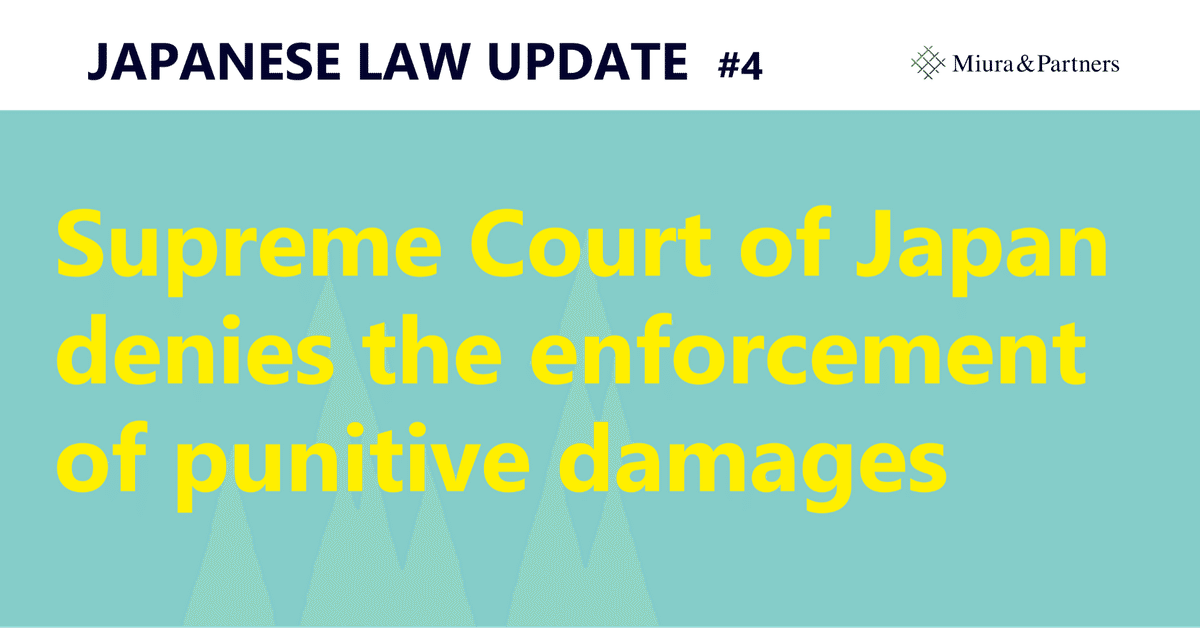
Japanese Law Update #4: Supreme Court of Japan denies the enforcement of punitive damages awarded in the United States
On May 25, 2021, the Supreme Court of Japan partially refused to enforce a US judgment which awarded punitive damages as well as compensatory damages (the “2021 Judgment ”). In Japan, most litigations are domestic. The 2021 Judgment is an important decision by the Supreme Court of Japan related to international cases. The 2021 Judgment confirms the precedent set in 1997, in which the Supreme Court of Japan found that punitive damages were against Japan’s public policy.
1. Enforcing Foreign Judgments in Japan
A judgment creditor who wishes to enforce a foreign judgment in Japan needs to meet the requirements pursuant to the Code of Civil Procedure of Japan (the “Code”). The Code requires, inter alia, that (i) the foreign court has the jurisdiction over the case, (ii) the defendant has received a proper service or has appeared without the service, (iii) the content of the foreign judgment is not against Japan’s public policy, and (iv) there is reciprocity between Japan and the foreign country where the foreign judgment was rendered. The requirement of reciprocity has been a major issue at the enforcement stage in Japan. For example, the Japanese court refused to enforce a judgment rendered by a Chinese court because of the lack of reciprocity.
2. Public Policy and Enforcement in Japan
The public policy requirement has also been considered an issue before the Japanese court. In 1997, the Supreme Court found that a US judgment which awarded punitive damages was unenforceable in Japan, because Japanese law did not recognize punitive damages and thus the content of the foreign judgment was against Japan’s public policy (the “1997 Judgment”).
3. Enforcing Punitive and Compensatory Damages
The 2021 Judgment is a case initiated by a US company (the “Plaintiff”) against a Japanese company (the “Defendant”), which was found infringing the Plaintiff’s trade secrets. The final judgment awarded the Plaintiff both punitive damages and compensatory damages. The Plaintiff initially enforced the judgment in the US, and then made an additional attempt in Japan for the unpaid portion of the damages. The 2021 Judgment found that punitive damages were not recognized in Japan; a foreign judgment which awarded punitive damages was against public policy and was therefore not enforceable in Japan. This is the same approach as taken in the 1997 Judgment.
The 2021 Judgment finds that when a foreign judgment awards both punitive damages and compensatory damages, the judgment may meet the requirements to be enforced in Japan except for the part regarding punitive damages. In the present case, the US judgement awarded the Plaintiff approximately USD185,000 as compensatory damages and approximately USD90,000 as punitive damages, and the Plaintiff was paid approximately USD135,000 through the enforcement process in the US.
The issue before the Supreme Court of Japan was what would happen when the Plaintiff had already received some portion of damages through the enforcement process in another country. The 2021 Judgment states that the proceeds collected through the enforcement in the US may only be applied against compensatory damages in the context of enforcement in Japan. Since the Plaintiff is only entitled to claim the amount equal to compensatory damages in Japan, the amount used as the basis for enforcement is the difference between the compensatory damages and the amount which the Plaintiff has been paid through the US enforcement process (i.e. USD185,000 - USD135,000 = USD50,000). However, this is much smaller than the difference between the total amount of punitive and compensatory damages and the amount which the Plaintiff has been paid through the US enforcement process (i.e. USD275,000 - USD135,000 = USD140,000).
4. Understanding the 2021 Judgment
This judgment by the Japanese court creates a conundrum. It seems that if the Plaintiff had first enforced the US judgment in Japan, then the Plaintiff would have been able to receive the full amount of compensatory damages (i.e. USD185,000). If that had been the case, then the Plaintiff might have been able to collect the remaining amount in the US, since the US court would allow the Plaintiff to be paid the full amount of awarded damages including punitive damages. Considering the 2021 Judgment, a creditor awarded both punitive and compensatory damages is encouraged to make a careful choice. In order to maximize the amount to be collected through the enforcement process, the creditor needs to choose the right timing of enforcement in Japan and elsewhere.
Author
Yoshie Midorikawa, Partner
Yoshie Midorikawa has extensive experience in complex disputes and arbitration under the rules of the ICC, SIAC, UNCITRAL, LCIA, and ICSID. Having worked with leading law firms in Japan and Singapore, she has handled parallel proceedings across multiple jurisdictions as well as domestic disputes before Japanese courts. Through learning in the United States, practicing in Singapore, and serving on an international law firm’s arbitration team, among other accomplishments, she has developed expertise operating in diverse international environments. She has also served as a board member of listed companies in Japan, improving their corporate governance. Her deep understanding of the civil law system, her working experience in international environments, including common law jurisdictions, and her knowledge of business, enable her to bring practical and nuanced legal solutions to international commercial disputes. She is listed among “Best Lawyers in Japan 2022(Litigation)”, “Best Lawyers in Japan 2021(Litigation)” by Best Lawyers.
この記事が気に入ったらサポートをしてみませんか?
